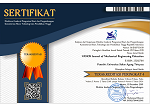Development of Learning Media Using the Sparkol Videoscribe Application on Measuring Tools at Vocational High School
Abstract
Keywords
Full Text:
PDFReferences
Mendikbud, “Peraturan Menteri Pendidikan dan Kebudayaan Republik Indonesia tentang Bimbingan dan Konseling pada Pendidikan Dasar dan Pendidikan Menengah,” Pedoman Eval. Kurikulum, 2014.
S. Soenarto, Suyanto, N. Widodo, Suparman, P. Karomah, and B. Haryadi, Media Pembelajaran. 2012.
A. Azhar, Media Pembelajaran. Jakarta: Raja Grafindo Persada, 2011.
R. Angkowo and A. Kosasih, Optimalisasi media pembelajaran. 2007.
E. Rima Wati, Ragam Media Pembelajaran. Yogyakarta: Kata Pena, 2016.
N. A. Handoyono and A. Mahmud, “Pengembangan Media Pembelajaran Berbasis Android pada Pembelajaran Electronic Fuel Injection,” INVOTEK J. Inov. Vokasional dan Teknol., vol. 20, no. 2, pp. 107–116, 2020, doi: 10.24036/invotek.v20i2.791.
S. Thiagarajan, D. S. Semmel, and M. I. Semmel, Instructional development for training teachers of exceptional children: A sourcebook. Twin Cities: Leadership Training Institute/Spesial Education, University of Minnesota, 2016.
V. Thiagarajan, “Response to ‘Comment on “Analytical solution for transient, diffusing fields inside a ring conductor with rectangular cross section (IET SMT 2008 Vol. 2 No. 5)” by Gratkowski and Ziolkowski,’” IET Science, Measurement and Technology. 2020, doi: 10.1049/iet-smt.2019.0090.
P. D. Sugiyono, Statistika untuk Penelitian. Bandung: Alfabeta., 2015.
N. S. Sukmadinata, Metode Penelitian Pendidikan. Bandung: PT Remaja Rosdakary, 2016.
K.-S. Chin, Q. Yang, C. Y. P. Chan, K. L. Tsui, and Y. Li, “Identifying passengers’ needs in cabin interiors of high-speed rails in China using quality function deployment for improving passenger satisfaction,” Transp. Res. Part A Policy Pract., vol. 119, pp. 326–342, 2019.
C. S. Otchia and S. Yamada, “Interactions between vocational and attitudinal skills in labour market outcomes: findings from the skills’ assessment of garment factory workers in Ethiopia,” J. Vocat. Educ. Train., 2021, doi: 10.1080/13636820.2019.1652675.
P. A. Pavlou, “Consumer acceptance of electronic commerce: Integrating trust and risk with the technology acceptance model,” Int. J. Electron. Commer., 2003, doi: 10.1080/10864415.2003.11044275.
A. Y. Utomo and D. Ratnawati, “PENGEMBANGAN VIDEO TUTORIAL DALAM PEMBELAJARAN SISTEM PENGAPIAN DI SMK,” TAMAN VOKASI, 2018, doi: 10.30738/jtvok.v6i1.2839.
Y. H. Liu, H. Maruyama, and S. Matsusaka, “Agglomeration process of dry ice particles produced by expanding liquid carbon dioxide,” Adv. Powder Technol., vol. 21, no. 6, pp. 652–657, 2010, doi: 10.1016/j.apt.2010.07.009.
A. Louw and N. Katznelson, “Transfer and reflection in the Danish dual model: Findings from development projects in the Danish vocational education and training programmes,” Nord. J. Vocat. Educ. Train., 2019, doi: 10.3384/njvet.2242-458x.199251.
T. Bevk and M. Golobič, “Contentious eye-catchers: Perceptions of landscapes changed by solar power plants in Slovenia,” Renew. Energy, 2020, doi: 10.1016/j.renene.2020.01.108.
M. B. Triyono, “The Indicators of Instructional Design for E- learning in Indonesian Vocational High Schools,” Procedia - Soc. Behav. Sci., 2015, doi: 10.1016/j.sbspro.2015.08.109.
S. Setuju, B. Rahmat Setiadi, D. Rantnawati, and A. Widowati, “The development digital book for vocational high schools,” Int. J. Recent Technol. Eng., vol. 8, no. 1C2, 2019.
DOI: http://dx.doi.org/10.30870/vanos.v7i1.14116
Refbacks
- There are currently no refbacks.

This work is licensed under a Creative Commons Attribution 4.0 International License.


.png)
.png)
